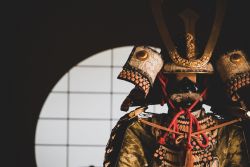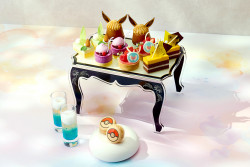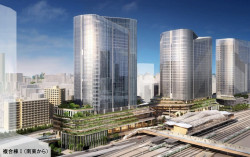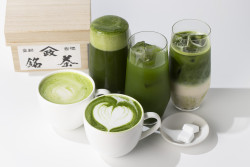
August 28, 2008
Sign of the Times
Say goodbye to “High Touch Town.” Roppongi is about to get a new Logo to go along with its new image
By Metropolis
Originally published on metropolis.co.jp on August 2008

Coutesy of Brett Bull
The date is March 6, 1989. The Yomiuri Giants are gearing up for what will be a championship season, the Nikkei index is holding steady at 32,000, the introduction of the nation’s first consumption tax is less than a month away, and Roppongi is now officially known as “High Touch Town.”
Among the dignitaries seated at a ceremony near the crossing with bouquets of flowers over their laps are the Minato Ward mayor and the chief of Azabu Police Station. They are guests for the unveiling ceremony of a pair of red, arch-shaped signs that have been affixed onto either side of the Shuto Expressway rolling high above. The writing on the placards will eventually come to give the entertainment district its moniker: High Touch Town.
But in the two decades since there has been
one problem.

The scene at Roppongi crossing (Courtesy of Brett Bull)
“There is no deep meaning in ‘High Touch Town,’” bemoans Hiroyuki Usui, a representative of the Roppongi Shopkeepers Promotion Association, of the now crusty and blackened markers. “People don’t know what it means.”
W
Whether to imply a touch of high class or to suggest a high-five greeting, the sign—which was created following a consultation with a Japanese teacher of English who operated a school above a soba shop near the Roi Building—will be replaced as part of a design competition to give the expressway a new look. The campaign coincides with the changing landscape of Tokyo’s notorious nightlife area.
Since the streets and alleys surrounding the crossing are primarily lined with gritty shot bars and teeming with pushy touts promoting their clubs, the shopkeepers association, which represents 250 businesses, would like to expand commercial activities by branding the area with a more positive image and atmosphere. “In order for us to make it happen,” Usui says, “we need to make Roppongi more exciting.”
In January, the association released a new slogan, “Roppongi Art Walk,” which refers to the recent opening of the Mori Art Museum, the Suntory Museum of Art, and the National Art Center, Tokyo. Flags bearing the slogan line Roppongi’s sidewalks, but given that they show drawings of young women toting shopping bags, it’s likely that the group also wants to promote a more tourist-friendly atmosphere.
The association will next focus on enhancing the look of the expressway. Five young artists have already submitted their designs for a new sign. The logo, it is hoped, will imbue an artistic feeling, one that will greet visitors when they emerge from the subway. It will be incorporated into a new series of Roppongi-themed souvenirs.
The project also includes refurbishment of the expressway’s grimy exterior that lies between the two crosswalks bridging Roppongi Dori. With a budget of ¥59 million, the association, working with the Metropolitan Expressway Company, expects construction to be completed in early 2009. Scaffolding is already in place.

The National Art Center, Tokyo. (Courtesy of the National Art Center, Tokyo)
Over the years, Roppongi has been called many things, but a town where one views fine paintings and sculpture has not been one of them. Flattened during World War II, the area became a G.I. hangout in the immediate postwar days. The decades that followed saw the neighborhood rise to become one of Tokyo’s more respectable districts. “Roppongi had a much more fashionable image,” Usui explains. “There were high-quality boutiques all through the area.”
Just after the collapse of the asset-inflated Bubble period in the early ’90s, however, the town slowly became a haven of seedy bars and sex parlors. Many observers note that the emergence of strip clubs in the mid-’90s was the start of the slip into the gutter.
The recent establishment of lavish, mixed-use office and commercial complexes boasting of top-name foreign corporate tenants has signaled a transformation. Mori Building’s Roppongi Hills opened in 2003, while Mitsui Fudosan’s Tokyo Midtown followed last year. And more are in the works. In nearby Azabu-Juban, developer Sumitomo is planning to open a 38-floor, 500-unit apartment tower at the end of next year. Mori announced in July that in 2012 it will complete a 46-floor office and residential complex on two hectares of land near the Iikura-Katamachi crossing. Dilapidated homes in the area west of Kamiyacho station have already been boarded up, with notices posted that Mori has taken over the property. In May of next year, the six-floor Centrum Roppongi Building, a “high-end” office complex, will rise on the former site of iconic disco Velfarre.
Perhaps the oddest example of Roppongi’s ongoing evolution is the story of the infamous TSK.CCC Terminal building, which sat roughly midway between Roppongi Hills and Tokyo Midtown until its demolition earlier this year (see sidebar). Once in the hands of the gangster Hisayuki Machii, whose period of power spanned the ’50s and ’60s, the property has recently been the subject of ownership disputes. Today it sits as a vacant lot.
But unlike in Machii’s heyday, the activities of boryokudan (a term often used to describe yakuza) have been getting pushed aside right along the rise of the new developments, explains Yuzuru Goto, administrative director of the shopkeepers association. “We have a few boryokudan offices,” says Goto, who handles communication channels between the association and the Azabu Police Station, “but their activities are minimal.”
Goto adds that illegal behavior, such as the practice of bottakuri—literally, to “rip off”—is not nearly as common as it used to be. “Years ago, guys in the street would ‘catch’ customers and invite them into their bars,” he explains. “The customers were enticed by an initial fee of ¥5,000. But then when it came time to pay the bill, the price had mysteriously risen to ¥20,000.”
Goto cites Kabukicho, the red-light district east of Shinjuku station, as a means of comparison. “There are a lot of ‘snacks’ in Roppongi staffed by ladies from Russia, America, Korea and England,” Goto says. “They drink with everyone, and there is no bottakuri. Kabukicho, however, hasn’t changed. It will go on like it is forever and ever.”

21-21 Design Sight (Courtesy of Masaya Yoshimura/Nacasa & Partners, Inc.).
Anyone who has been accosted by an aggressive Roppongi street tout will likely find the director’s view to be a bit optimistic. It is certainly true, however, that shady businesses throughout Tokyo have felt the pinch in recent years. Crackdowns on hostess clubs, discos and sex parlors have come as a result of stricter enforcement of the Law Regulating Adult Entertainment Businesses, which dictates that all entertainment operations shut their doors by 1am.
Kabukicho has been a prime target. Enforcement of the statute has made business for fuzoku (sex-related) establishments nearly impossible. Cabaret clubs have either had to abide by the law or employ staff to watch the street for cops on patrol. In Roppongi, Velfarre attempted to remain open in 2006 by filing paperwork for an exception, but it was rejected.
Interpretation of this law, however, is not exactly clear-cut. A business where the customer is not being entertained by shop staff is considered permissible. Run-of-the-mill bars fall into this category.
A creative exploitation of this loophole has been the manifestation of the “girls bar,” in which dolled-up ladies pour drinks and light cigarettes from behind a counter—not next to the customer, as is usual (and illegal after 1am) in typical hostess clubs. The bar Seven Seas, situated between Roppongi crossing and Tokyo Midtown, claims to operate 24 hours a day. On evenings from around 7pm, pairs of girls can regularly be seen on the sidewalk handing out coupons for a complimentary beer.
Rumors about the reasons for the stricter enforcement have varied from preparation for Tokyo’s bid for the 2016 Olympics to facilitating urban redevelopment of valuable property.
To be sure, a highbrow image and the early stages of a cleanup of undesirable activities are not going to entirely put an end to Roppongi’s wild and wooly ways; rather, they’re more about creating a balance. After all, the association believes, not everyone in Tokyo is hung over on Saturday morning.
“The Roppongi nightlife image is firmly in place now,” Usui says. “But we want to welcome people to Roppongi when the sun is up as well.”
For more on this story, see www.tokyoreporter.com.







